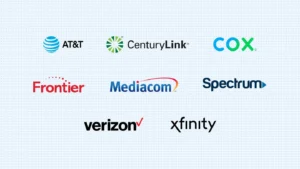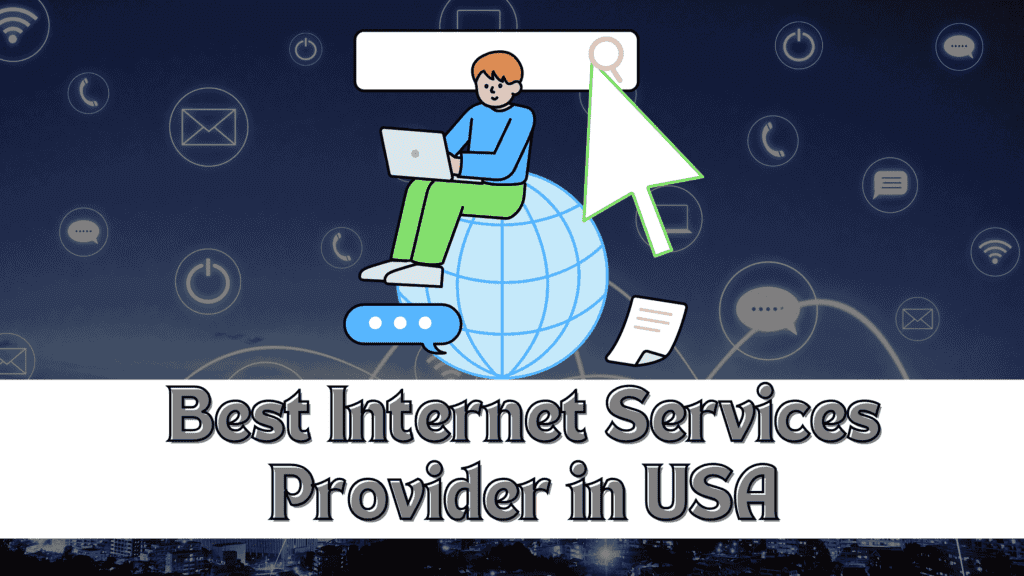 In today’s digital world, having access to a fast and reliable internet connection is essential for both personal and professional activities. Whether you’re working from home, streaming movies, gaming, or staying connected with friends and family, a dependable internet connection has become a cornerstone of modern life. The United States has a diverse range of Internet Service Providers (ISPs) offering various services, from cable and DSL to fiber-optic and satellite internet.
In today’s digital world, having access to a fast and reliable internet connection is essential for both personal and professional activities. Whether you’re working from home, streaming movies, gaming, or staying connected with friends and family, a dependable internet connection has become a cornerstone of modern life. The United States has a diverse range of Internet Service Providers (ISPs) offering various services, from cable and DSL to fiber-optic and satellite internet.
This detailed guide explores some of the top internet service providers in the U.S., focusing on their speed, coverage, recent developments, and unique offerings. With a comprehensive look at these providers, you’ll be better equipped to choose the best service based on your specific needs.
1. Xfinity (Comcast)
Overview:
Xfinity, a brand under Comcast, is one of the largest ISPs in the U.S., serving more than 32 million customers across the country. Known for its fast speeds and expansive coverage, Xfinity provides high-speed internet with cable services and, in select areas, fiber-optic internet offerings.
Key Features:
- Speeds: Xfinity offers speeds ranging from 50 Mbps to 2 Gbps, with their top-tier Gigabit Pro Fiber service providing speeds up to 10 Gbps for ultra-high bandwidth users.
- Availability: Available in over 40 states, Xfinity is one of the most widely accessible ISPs in the U.S., making it a popular choice for customers.
- Pricing: Plans start as low as $25 per month, with higher-speed plans available at prices of $80–$100 per month depending on the location.
- Customer Support: Xfinity provides 24/7 customer support through phone, online chat, and a robust online help center.
Pros:
- Wide coverage across the country
- Gigabit and multi-gigabit options available
- No data caps on most plans
Cons:
- Prices may rise after the initial contract period
- Some customers report inconsistent service in certain areas
2. AT&T Internet
Overview:
AT&T offers a mix of DSL and fiber-optic internet services and is one of the largest providers in the U.S. Their fiber-optic offerings provide some of the fastest residential speeds available, while DSL is more commonly available in rural areas.
Key Features:
- Speeds: AT&T’s fiber internet offers speeds up to 5 Gbps, while their DSL service supports speeds of up to 18 Mbps.
- Availability: AT&T’s fiber-optic network reaches approximately 30 million people, with a more expansive presence in urban areas.
- Pricing: AT&T’s fiber plans start at $55 per month for speeds up to 300 Mbps, with top-tier speeds costing up to $180 per month.
- Customer Support: AT&T provides excellent customer service with 24/7 phone support and a dedicated online troubleshooting center.
Pros:
- Strong fiber coverage with high-speed & best for gamers options
- No data caps on fiber plans
- Strong reputation for reliable service
Cons:
- DSL plans have limited speed and availability
- Fiber service availability can be restricted to specific regions
3. Charter Spectrum
Overview:
Spectrum, owned by Charter Communications, serves over 30 million customers. Spectrum offers cable internet services with competitive speeds and pricing, making it one of the top ISPs in the U.S.
Key Features:
- Speeds: Spectrum offers speeds from 100 Mbps to 1 Gbps, making it a great option for households with high internet demands.
- Availability: Spectrum provides services in 41 states, including major metropolitan areas and many suburban regions.
- Pricing: Plans start at $49.99 per month for speeds of 100 Mbps, with higher speeds available at competitive pricing.
- Customer Support: Spectrum’s customer support includes 24/7 access through phone, online chat, and in-person visits at retail locations.
Pros:
- Reliable high-speed internet with no data caps
- Extensive coverage across the U.S.
- Simple pricing structure without hidden fees
Cons:
- Price increases after the first year
- Limited availability in rural areas
4. Verizon Fios
Overview:
Verizon Fios delivers one of the best fiber-optic internet experiences in the U.S., providing ultra-fast speeds and reliable service. Known for its speed and consistency, Fios is particularly popular in urban areas along the East Coast.
Key Features:
- Speeds: Verizon Fios offers speeds ranging from 50 Mbps to 2 Gbps with its fiber-optic services.
- Availability: Fios is available in select areas, primarily in northeastern states like New York, New Jersey, and Virginia.
- Pricing: Fios internet plans start at $39.99 per month for speeds up to 200 Mbps, with top-tier options priced around $79.99 per month for 940 Mbps.
- Customer Support: Verizon provides strong customer service through phone, chat, and in-store support.
Pros:
- Fast and reliable fiber-optic internet
- No data caps on fiber plans
- Excellent customer support and service reliability
Cons:
- Limited availability (mostly on the East Coast)
- Higher pricing for gigabit plans
5. Cox Communications
Overview:
Cox offers internet services primarily in the southwestern U.S. and parts of the Midwest. They provide cable internet services with flexible speed options to suit various user needs.
Key Features:
- Speeds: Cox offers internet plans ranging from 25 Mbps to 1 Gbps, depending on the region and availability.
- Availability: Cox operates in 18 states, primarily serving customers in Arizona, California, and Georgia.
- Pricing: Cox plans start at $29.99 per month, with speeds of up to 1 Gbps available at higher price points, typically ranging from $50 to $100.
- Customer Support: Cox provides 24/7 customer service through phone, live chat, and a detailed online help center.
Pros:
- Reliable service with affordable plans
- High-speed gigabit internet available
- Flexible plans to suit different needs
Cons:
- Service availability is limited to specific states
- Some customers report issues with customer service response times
6. Frontier Communications
Overview:
Frontier is a telecommunications company offering both DSL and fiber-optic internet services. Known for its affordable plans, Frontier provides internet options for both urban and rural customers.
Key Features:
- Speeds: Frontier’s fiber internet service offers speeds up to 5 Gbps, while DSL speeds vary based on location.
- Availability: Frontier’s services are available in 25 states, with a strong presence in rural and suburban areas.
- Pricing: Fiber plans from Frontier start at $49.99 per month, with top-tier options available at around $80 per month.
- Customer Support: Frontier offers support via phone, online chat, and an extensive help center on their website.
Pros:
- Low-cost fiber plans
- Great availability in rural and underserved areas
- No data caps on fiber plans
Cons:
- DSL speeds may not meet the needs of high-demand users
- Fiber availability is limited to select areas
7. T-Mobile Home Internet
Overview:
T-Mobile has recently entered the home internet market, offering wireless broadband services. Their service is ideal for users in areas where traditional wired internet may not be readily available.
Key Features:
- Speeds: T-Mobile’s home internet service provides speeds ranging from 72 Mbps to 245 Mbps, depending on location and demand.
- Availability: T-Mobile’s service is expanding rapidly, with availability in several regions across the U.S., particularly in rural and underserved areas.
- Pricing: T-Mobile Home Internet plans are priced at $50 per month with no additional fees or data caps.
- Customer Support: T-Mobile offers 24/7 customer support via phone, live chat, and a mobile app for managing your account.
Pros:
- Affordable pricing with no hidden fees
- Flexible and easy-to-use wireless internet solution
- Expanding availability, especially in rural areas
Cons:
- Speeds may not be sufficient for high-demand households
- Service is not available in all areas
8. Mediacom
Overview:
Mediacom is a cable internet provider serving over 1 million customers, primarily in smaller cities and rural areas. They offer internet speeds ranging from 60 Mbps to 1 Gbps, with a focus on providing reliable service to less urbanized areas.
Key Features:
- Speeds: Mediacom offers speeds from 60 Mbps to 1 Gbps, providing options for various household needs.
- Availability: Mediacom is available in 22 states, mostly in the Midwest and Southeastern U.S.
- Pricing: Pricing for Mediacom internet plans starts at $39.99 per month, with gigabit-speed plans available starting at $79.99 per month.
- Customer Support: Mediacom offers customer support through phone, email, and online help resources.
Pros:
- Affordable pricing options
- Fast internet speeds for streaming and gaming
- Great availability in rural areas
Cons:
- Limited availability compared to larger ISPs
- Some customers report occasional connectivity issues
9. HughesNet
Overview:
HughesNet specializes in satellite internet services, providing a viable option for rural and underserved areas. With satellite technology, HughesNet ensures that even remote locations can access the internet.
Key Features:
- Speeds: HughesNet offers speeds up to 25 Mbps, which is lower than other ISPs but suitable for basic browsing, email, and video streaming.
- Availability: HughesNet is available nationwide, including in rural and remote areas where wired services are not an option.
- Pricing: Plans begin at $64.99 per month, with pricing based on data allowances.
- Customer Support: HughesNet provides support through phone, email, and an online help center.
Pros:
- Nationwide availability, especially in rural areas
- No installation fees for standard plans
- Easy setup for remote locations
Cons:
- Slower speeds compared to cable and fiber providers
- Data limits can be restrictive for heavy users
10. Starlink (SpaceX)
Overview:
Starlink, a satellite internet service from SpaceX, aims to provide high-speed internet worldwide. Its service is particularly beneficial for rural and remote locations that are underserved by traditional ISPs.
Key Features:
- Speeds: Starlink offers speeds ranging from 50 Mbps to 250 Mbps, with plans to improve speeds further as more satellites are deployed.
- Availability: Starlink is available in most U.S. locations, particularly in remote or rural areas.
- Pricing: The cost for Starlink service is $110 per month, with an upfront cost for equipment.
- Customer Support: Starlink offers customer support through email, online chat, and an online support portal.
Pros:
- Ideal for rural and remote areas
- No data caps on most plans
- Continually improving service speeds and coverage
Cons:
- Higher upfront equipment costs
- Speeds may not be as fast as fiber-optic or cable options
Conclusion
Choosing the best ISP depends on factors such as location, speed requirements, pricing, and customer support. The U.S. has a broad range of providers to suit varying needs, from traditional cable and fiber-optic services to newer satellite and wireless options. As technology evolves, ISPs continue to expand and innovate, providing faster, more reliable internet for everyone. Be sure to assess your specific requirements and check availability in your area to find the best internet service provider for you.


